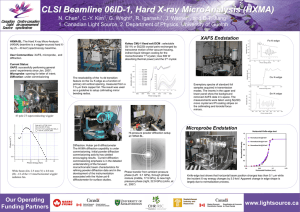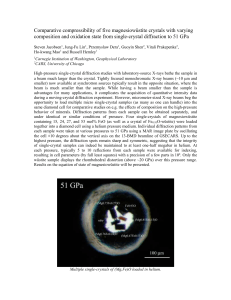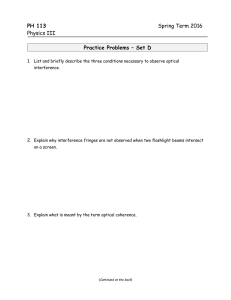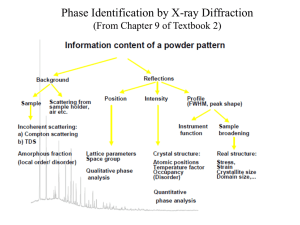A scanning angle energy-dispersive X-ray diffraction (SA-EDXD) technique
advertisement
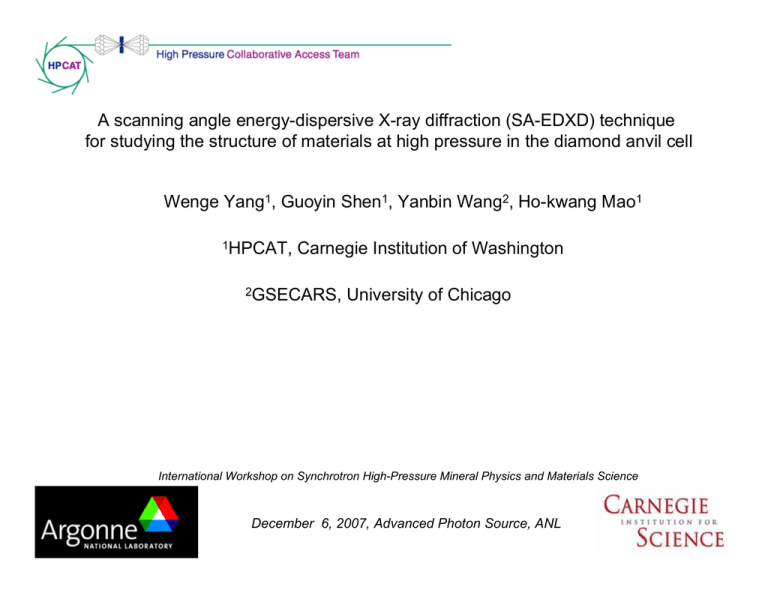
A scanning angle energy-dispersive X-ray diffraction (SA-EDXD) technique for studying the structure of materials at high pressure in the diamond anvil cell Wenge Yang1, Guoyin Shen1, Yanbin Wang2, Ho-kwang Mao1 1HPCAT, Carnegie Institution of Washington 2GSECARS, University of Chicago International Workshop on Synchrotron High-Pressure Mineral Physics and Materials Science December 6, 2007, Advanced Photon Source, ANL Outlines Experimental setup Data collection procedure Data Analysis software package Comparison with routine monochromatic ADX Application with Crystalline and amorphous materials Summary Experimental setup Beam stop White synchrotron radiation Diffraction beam ED detector HPCAT 16BMB station Experimental parameters: Ge EnergyDispersive Detector Incident beam collimation Diffraction beam collimation Pb shielding Pb shielding Energy range: 1 – 100 keV Focus beamsize: 5-50 um 2theta range: 2-40 degrees eccentricity: ~5 um Detector to sample distance: ~350 mm Typical horizontal acceptance: 30-100 um (0.08-0.28 mrad) Typical vertical acceptance: 150-500 um (0.42-1.4 mrad) Tip horizontal opening: 30um – 1000 um Support facilities Air-pad and granite for smooth 2 theta change Variable focus distance/size with remote control of K-B mirror location Separation of sample stack with rotation stage Automatic L-N2 refill system Data collection procedure Take EDXD patterns at each 2θ angle, with increment Δ2θ; In order to achieve the regular Angle-dispersive x-ray diffraction resolution, only a coarse 2 theta scan is needed; Only scan of 2 theta in horizontal direction is available … Data Analysis package Intensity correction: I obs (Q) = PAG[ I coh (Q) + I inc (Q) + I mul (Q) + I back (Q)] P: the polarization factor, A: the absorption factor, G: the geometric factor, Icoh, Iinc, and Imul: the coherent, incoherent, multiple scattering intensities, Iback is the background scattering from the surrounding materials Diffraction volume correction: sin( 2θ ) , when L ≤ D wi wd L= wi wd + tan(2θ ) sin(2θ ) 1 , when L > D 2 wi wd ( L − D) tan(2θ ) − sin(2θ ) 4 wi, wd are widths of incident and diffraction beam L diffraction length along incident beam D sample diameter SA-EDXD scan on Fe2O3 at 25.4 GPa in DAC 2-Theta Angle (˚) 24 6 0 92 Energy (keV) Intensity as a function of energy and 2-theta angle Energy Dispersive Diffraction (2-theta @ 8˚) 2000 1800 1600 1400 Intensity 1200 1000 800 600 400 200 0 0 10 20 30 40 50 Energy (keV) 60 70 80 90 Angle dispersive diffraction profiles at different energies Angle Dispersive Diffraction (E=40 keV) 3000 1200 2500 1000 2000 800 Intensity Intensity Angle Dispersive Diffraction (E=20 keV) 1500 600 1000 400 500 200 0 0 600 800 1000 1200 1400 1600 1800 2000 2200 2400 600 800 1000 1200 1400 1600 1800 2000 2200 2400 2-theta Angle (centi-degree) 2-theta Angle (centi-degree) Angel Dispersive Diffraction (E=60 keV) 300 Diffraction relative intensity is modified as you change the ADX energy 250 Intensity 200 Applying the energies close to element Absorption edges, one can get anomalous Scattering effects to get element specific Site occupation; 150 100 50 0 600 800 1000 1200 1400 1600 2-theta Angle (centi-degree) 1800 2000 2200 2400 Diffraction from low-Z materials; Comparison with regular angle-dispersive diffraction with monochromatic beam SA-EDXD after channel binning Monochromatic beam Powder Diffraction @ E=33.674 keV taken at 16 IDB 2000 1.40E+03 1800 1.20E+03 1600 1.00E+03 1400 1200 intensity Intensity 8.00E+02 6.00E+02 1000 800 4.00E+02 600 2.00E+02 400 0.00E+00 6.00E+00 8.00E+00 1.00E+01 1.20E+01 1.40E+01 1.60E+01 -2.00E+02 1.80E+01 2.00E+01 2.20E+01 2.40E+01 200 0 2 theta 600 800 1000 1200 1400 1600 2 theta 1800 2000 2200 2400 Amorphous Ni-Nb BMG at 20 GPa in DAC (a) 2 24.782 keV 30.969 keV 37.155 keV 43.344 keV 49.531 keV 55.718 keV 61.905 keV 68.092 keV 74.279 keV 4 Intensity (a.u.) 10 6 5 4 3 2 3 10 6 5 4 3 5 10 15 20 2-theta (º) 25 30 (b) 5 First S(Q) result with SA-EDXD technique Ni60Nb40 at 20 GPa S(Q) 4 3 2 1 5 10 -1 Q value (Å ) 15 Comparison with regular monochromatic ADX Advantage: Multi energy data collected simultaneously, which could be used for anomalous diffraction methods; High signal to noise ratio, which is specially useful for low-Z crystalline, liquid and amorphous studies; Easy data interpretation; No fluorescence background; … challenges: Data collection time longer; Stable experimental setup is required, including small sphere of confusion, steady incident intensity and spectrum, stable sample support… For crystalline sample, fine powder is required to avoid the texture effects from the point detector; Escape lines, can be removed effectively, but interference with diffraction lines; … Summary A scanning angle EDXD method has been developed for structure study with DAC A dedicated analysis software package has been written in IDL Comparison with routine angle-dispersive diffraction with monochromatic beam shows similar angular resolution Good signal to noise ratio makes it very promising to study low-scattering materials (low-Z, amorphous, liquid …) Multiple energy data can be used for structure refinement and anomalous diffraction effects Partial structure factor of amorphous structure is under development.
